| CPC G06T 19/006 (2013.01) [G02B 27/017 (2013.01); G02B 27/0172 (2013.01); G02B 2027/0105 (2013.01); G02B 2027/0138 (2013.01); G02B 2027/0174 (2013.01); G02B 2027/0187 (2013.01)] | 22 Claims |

|
1. A display system comprising:
a head-mounted display comprising one or more waveguides configured to project light to a user to display augmented reality image content, wherein the one or more waveguides are further configured to transmit light from a surrounding environment to the user;
one or more processors; and
one or more computer storage media storing instructions that, when executed by the one or more processors, cause the one or more processors to perform operations comprising:
tracking ocular movements of the user;
determining a neurological condition associated with one or more abnormalities in the tracked ocular movements; and
providing one or more stimuli to inhibit the one or more abnormalities in the tracked ocular movements or to retrain one or more portions of the brain associated with the neurological condition, wherein the one or more stimuli comprise virtual content displayed to the user in response to the determined neurological condition.
|